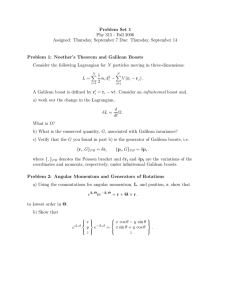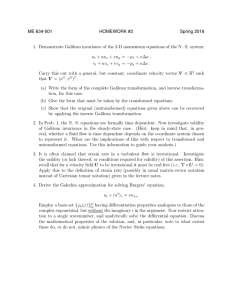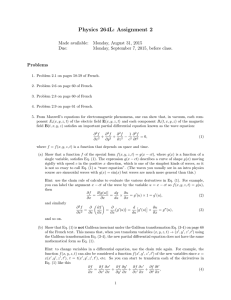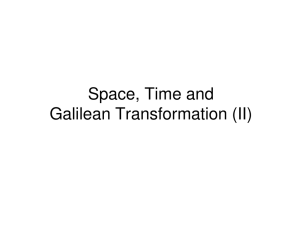Implications of Galilean Electromagnetism in Numerical Modeling
advertisement
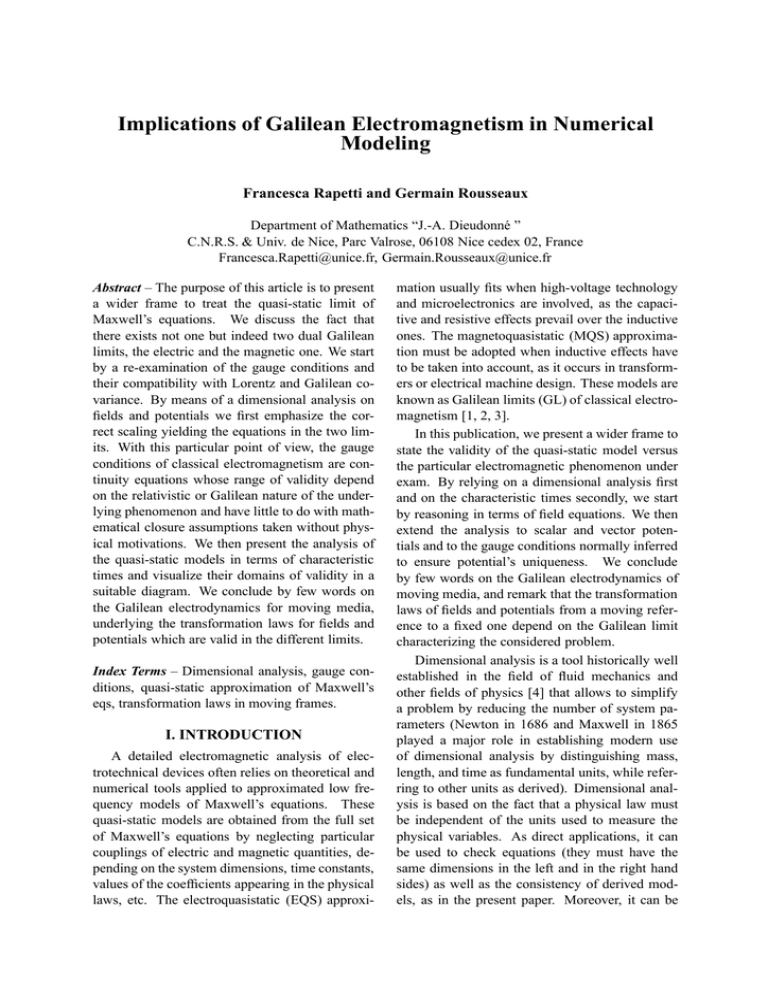
Implications of Galilean Electromagnetism in Numerical Modeling Francesca Rapetti and Germain Rousseaux Department of Mathematics “J.-A. Dieudonné ” C.N.R.S. & Univ. de Nice, Parc Valrose, 06108 Nice cedex 02, France Francesca.Rapetti@unice.fr, Germain.Rousseaux@unice.fr Abstract – The purpose of this article is to present a wider frame to treat the quasi-static limit of Maxwell’s equations. We discuss the fact that there exists not one but indeed two dual Galilean limits, the electric and the magnetic one. We start by a re-examination of the gauge conditions and their compatibility with Lorentz and Galilean covariance. By means of a dimensional analysis on fields and potentials we first emphasize the correct scaling yielding the equations in the two limits. With this particular point of view, the gauge conditions of classical electromagnetism are continuity equations whose range of validity depend on the relativistic or Galilean nature of the underlying phenomenon and have little to do with mathematical closure assumptions taken without physical motivations. We then present the analysis of the quasi-static models in terms of characteristic times and visualize their domains of validity in a suitable diagram. We conclude by few words on the Galilean electrodynamics for moving media, underlying the transformation laws for fields and potentials which are valid in the different limits. Index Terms – Dimensional analysis, gauge conditions, quasi-static approximation of Maxwell’s eqs, transformation laws in moving frames. I. INTRODUCTION A detailed electromagnetic analysis of electrotechnical devices often relies on theoretical and numerical tools applied to approximated low frequency models of Maxwell’s equations. These quasi-static models are obtained from the full set of Maxwell’s equations by neglecting particular couplings of electric and magnetic quantities, depending on the system dimensions, time constants, values of the coefficients appearing in the physical laws, etc. The electroquasistatic (EQS) approxi- mation usually fits when high-voltage technology and microelectronics are involved, as the capacitive and resistive effects prevail over the inductive ones. The magnetoquasistatic (MQS) approximation must be adopted when inductive effects have to be taken into account, as it occurs in transformers or electrical machine design. These models are known as Galilean limits (GL) of classical electromagnetism [1, 2, 3]. In this publication, we present a wider frame to state the validity of the quasi-static model versus the particular electromagnetic phenomenon under exam. By relying on a dimensional analysis first and on the characteristic times secondly, we start by reasoning in terms of field equations. We then extend the analysis to scalar and vector potentials and to the gauge conditions normally inferred to ensure potential’s uniqueness. We conclude by few words on the Galilean electrodynamics of moving media, and remark that the transformation laws of fields and potentials from a moving reference to a fixed one depend on the Galilean limit characterizing the considered problem. Dimensional analysis is a tool historically well established in the field of fluid mechanics and other fields of physics [4] that allows to simplify a problem by reducing the number of system parameters (Newton in 1686 and Maxwell in 1865 played a major role in establishing modern use of dimensional analysis by distinguishing mass, length, and time as fundamental units, while referring to other units as derived). Dimensional analysis is based on the fact that a physical law must be independent of the units used to measure the physical variables. As direct applications, it can be used to check equations (they must have the same dimensions in the left and in the right hand sides) as well as the consistency of derived models, as in the present paper. Moreover, it can be used to reason on complex physical situations by analyzing reduced models (a model of a few centimeters can give insight on the dynamics of jet airplane, for example). The main difficulty with dimensional analysis is the selection of the fundamental parameters for a given problem. In Sections II and III, we apply dimensional analysis to derive the Galilean quasi-static models and in Section IV, we explain how the scalings characterizing these models can be deduced on the basis of fundamental physical parameters by applying the famous Pi theorem of Vaschy-Buckingham [5]. II. GALILEAN LIMITS OF MAXWELL’S EQUATIONS An electromagnetic phenomenon happens in a spatial arena of extension ℓ in a duration τ . The arena is a continuous medium with constitutive properties ǫ, µ, and σ, which are supposed to be constant for simplicity (otherwise they are time and space dependent tensors). Applying the Vaschy-Buckingham theorem of dimensional analysis, we can construct dimensionless parameters which would characterize the electromagnetic response of the continuous medium. As we will deal with Galilean approximations, we introduce the typical velocity v of the system with modulus |v| = ℓ/τ and we compare it with the light celer√ ity in the continuous medium cm = 1/ ǫµ. The Galilean limit (quasi-static approximation) corresponds to |v| ≪ cm . This assumption is not sufficient to choose between the MQS or the EQS approximations. Let us set E = eE and B = bB, where e, b are reference quantities and E, B are non-dimensional quantities of order 1. We just recall that in dimensional analysis the spatial (resp. time) differentiation ∂x E (resp. ∂t E) is equivalent to eℓ (resp. τe ). Moreover, we adopt the notation a ∼ b to say that the quantities a and b have the same magnitude order, whereas a ≃ b when a and b are approximatively equal. In the empty space, Faraday’s law and the expression of |v| yield ∇ × E = −∂t B, b e ∼ , ℓ τ e ∼ |v| b. (1) The generalized Ampère’s law and the expression √ of cm , which equals the light speed c = 1/ ǫ0 µ0 , result in ∇×H = −∂t D, ǫ0 e b ∼ , µ0 ℓ τ b∼ |v| e. (2) c2 Thus, two scalings appear, the first e ∼ |v| b and the second b ∼ |v| e. In the relativistic regime, c2 i.e. |v| ∼ c, the two scalings are the same. In the Galilean regime, i.e. |v| ≪ c, the two scalings are different and if one replaces the expression of b given in (2) into the expression of e given in (1), we gets |v| ∼ c which is in contradiction with the Galilean assumption |v| ≪ c. This means that in the Galilean regime, the two scalings are not simultaneously valid, thus the Faraday’s and generalized Ampère’s laws cannot be coupled. To choose the scaling, we have to look at the sources (charges or currents) of the electromagnetic phenomenon under consideration. Let us suppose to be once again in the empty space. The Gauss’s theorem yields ∇ · D = ρ, ǫ0 e ∼ ρ, ℓ (3) and Ampère’s theorem results in ∇ × H = J, b ∼ J. µ0 ℓ (4) Then, “dividing” (4) by (3), we get b µ0 ℓ c ǫ0ℓe ∼ J , cρ J b ∼ , cρ c ǫ0 µ 0 e J cb ∼ . (5) cρ e Therefore, if J ≫ ρ c, that is when the dielectric effect of charges is negligible, we obtain e ≪ c b and the MQS approximation is the correct one. On the contrary, if J ≪ ρ c, that is when the conducting effect is negligible, we get e ≫ c b and the EQS approximation has to be adopted. In fact, the conditions |v| ≪ c and e ≪ c b are compatible with the MQS scaling e ∼ |v| b (with the EQS scaling we would obtain c b ≫ c b that is a nonsense). On the contrary, the conditions |v| ≪ c and e ≫ c b are compatible with the EQS scaling c b ∼ |v| c e (with the MQS scaling we would obtain |v| b ≫ c b, thus |v| ≫ c against the Galilean regime assumption |v| ≪ c). From the above considerations, slowly time varying fields can be described by either the Galilean electric limit of Maxwell’s equations given by ∇ × E ≃ 0, ∇ · D = ρ, ∇ × H = J + ∂t D, ∂t ρ + ∇ · J = 0, (6) or the Galilean magnetic limit given by ∇ × E = −∂t B, ∇ · B = 0, ∇ × H ≃ J, ∇ · J = 0, (7) or the Galilean stationary limit of Maxwell’s equations, also known as quasi-stationary conduction (QSC) approximation, where no time derivative appears at very low frequencies ∇ × E ≃ 0, ∇ · D = ρ, ∇ × H ≃ J, ∇ · B = 0. (8) All models have to be completed with classical constitutive relations and suitable boundary and initial conditions. The internal consistency of models (6) and (7) by using the Jefimenko form [7] of the solutions to the wave equation for fields works out neatly. It can be easily shown that the two scalings (1) and (2) obtained here by dimensional analysis are in agreement with those expressed in terms of fields and time scalings given in [6]. Note however that the existence of two Galilean limits is not so obvious if we naively take the limit c → +∞ in equations (6) and (7) (see [3] for the details). The two limits can be traced back to the possibility of keeping either one of the two constants ǫ0 , µ0 finite, while the second one “approaches to zero”, even if we are aware of the fact that these two physical quantities never tend to zero in real life. As explained in the conclusion of [1], we may understand the magnetic limit by keeping µ0 only, and by writing ǫ0 = 1/(µ0 c2 ) where c approaches infinity; for the electric limit, we reverse the role of µ0 and ǫ0 . One can anyway be bothered by the presence of light speed c in the above expressions despite we are considering phenomena where |v| ≪ c. In Galilean electromagnetism, the appearing veloc√ ity is cu = 1/ ǫ0 µ0 . This velocity is independent of specific units (same value with Gaussian or SI units) and arises from using only action-ata-distance forces in which an instantaneous propagation is assumed [8]. It can thus be considered as a fundamental constant in nature. We are used to identify cu with c the speed of light in vacuum because these velocities have the same numerical value. We have to remember that the speeds cu and c emerge from different physical considerations (Maxwell indeed has been the first one who stated cu = c in 1862) but we are not going to develop this point here. and B by the well-known relations E = −∂t A − ∇V, B = ∇ × A. (9) The equations of classical electromagnetism in terms of potentials are 1 A µ0 J = ( 2 ∂tt − ∆) V ρ/ǫ0 c and their quasi-static approximation for |v| ≪ c yields −∆A ≃ µ0 J, −∆V ≃ ρ/ǫ0 . (10) In terms of magnitude orders, let us write again A = aA and V = VV, then “dividing” in (10) the first equation by the second one, we get a J ∼ 2, V ρc J ca ∼ . V ρc (11) As already seen, in the MQS approximation J ≫ ρ c so c a ≫ V (in fact, the correct scaling is V ≈ |v| a) and in the EQS approximation J ≪ ρ c V). so c a ≪ V (and the correct scaling is a ≈ |v| c2 Let us look back to (9): B = ∇ × A gives always b ∼ aℓ whereas E = −∂t A−∇V yields e ∼ aτ + Vℓ . On the one hand, when c a ≪ V, with |v| ≪ c, |v| a ≪ V, ℓ a ≪ V, τ a V ≪ , τ ℓ (12) so e ∼ Vℓ , thus E = −∇V which is compatible with the EQS model where ∇ × E = 0. On the other hand, if c a ≫ V, a ≫ V but |v| ≪ c, a V ∼ , τ ℓ (13) so E = −∂t A − ∇V is compatible with the MQS equation ∇ × E = −∂t B. Let us finally consider the well-known gauge conditions usually adopted in the QS context for A and V . From the Lorenz condition ∇·A+ c12 ∂t V = 0 we get c a+ |v| c V ∼ 0. In the MQS approximation, the Lorenz condition becomes the Coulomb one (∇ · A = 0) as c a ≫ V and |v| ≪ c. But in the EQS limit, as c a ≪ V but |v| ≪ c, the two terms ∇ · A and c12 ∂t V have the same magnitude order, and thus Lorenz gauge condition holds. Coulomb and Lorenz conditions in the empty space are in reality a particular case of a more general condition, that reads III. POTENTIALS AND GAUGE CONDI-TIONS IN THE GALILEAN REGIME ∇ · A + µǫ∂t V = −µσV, We now focus on the magnetic vector potential A and the scalar electric one V associated to E valid in a medium with electric permittivity ǫ and magnetic permeability µ, introduced by Stratton (14) [9] in 1941 to cope with the propagation of electromagnetic waves in Ohmic conductors with electric conductivity σ 6= 0. IV. THE GALILEAN REGIME AND ITS CHARACTERISTIC TIMES Quasi-static models are valid when τem = ℓ/c, the light transit time in the medium, is small compared to τ (cf. Table 1). Table 1: Range of the characteristic time τ for the different models derived from Maxwell’s eqs Full set of Maxwell’s eq. 0 ≤ τ ≤ τem Quasi-static regime τem ≤ τ ≤ τm , τe Static regime τ ≥ τm , τe Together with τem , we need q to define three 1 1 ⋆ , the other quantities, namely ℓ = σ µǫ = ση constitutive length (η is the medium impedance), τe = ǫ/σ, the electric charge diffusion time (i.e., the characteristic time with which the unpaired electric charge decays in a conductor), and τm = µσℓ2 , the current density diffusion time (i.e., the characteristic time with which the current density and hence the magnetic field penetrates in a conductor). A natural question arises: “where do these quantities come from ?”. Moreover, “which is the role of these constants in the definition of the quasi-static regimes ?”. √ (here c denotes cu = 1/ µǫ). We start by re√ marking that τem = τe τm , i.e. τem defines the geometric mean of the previously defined quantities τe and τm . The three time constants can be arranged in two different ways, either τm > τe or τm < τe (Fig. 1). In order to underline the dependence of τm and τe on the length ℓ, it is better to consider a twodimensional visualization, where one axis reflects the effect of τ and the other that of ℓ, as firstly proposed in [10]. We thus consider the plane (x, y) where x := log(τ /τem ) and y := log(ℓ/ℓ∗ ) and we separate it in sectors by remarking that τ = τem , log(τ /τem ) = log(1) (x = 0), τ = τe , log(τ /τem ) = log(ℓ∗ /ℓ) (y = −x), τ = τm , log(τ /τem ) = log(ℓ/ℓ∗ ) (y = x). The Galilean regime, characterized by τem ≪ τ , is located where x > 0 on the plane (x, y) of Fig. 2. On the one hand, the expansion b ∼ (τm /τ )b + (τem /τ )2 b, resulting from the generalized Ampere’s theorem, with the MQS scaling e ∼ |v|b, has to be truncated at the first term in (τm /τ ) as the second term in (τem /τ )2 is negligible (this means J ≫ ∂t D). On the other hand, in the expansion b ∼ (τ /τe )b + b, resulting from the generalized Ampere’s theorem, with the EQS scaling e ∼ (c2 /|v|)b, the first term in (τ /τe ) is negligible with respect to the second one (this means J ≪ ∂t D). y = log (τm / τem ) Full set of Maxwell’s eq. τe 0 MQS τem Statics τ = τm τm Galilean MQS τ Special relativity Full set of Maxwell’s eq. τm 0 Statics EQS Galilean QSC τe τem τ Fig. 1. Case τm > τe (up) and τm < τe (down). Galilean QSC x = log ( τ / τ em ) Special relativity Galilean EQS To understand their origin and importance, we perform a dimensional analysis of the Stratton condition (14), that yields a V + µǫ ∼ µσV, ℓ τ I + II ∼ III. By computing three dimensionless ratios, namely II/I, III/I, and III/II, we see appearing the characteristic time constants: II I III I V ∼ |v| c ca ℓ V ∼ ℓ∗ ca V = τem τ ca , τm V = τem ca = III II τem V τe ca ∼ τ τe , τ = τe Fig. 2. Graphical representation of electromagnetic model validity. Let us go back to the gauge condition validity. From Stratton condition with the MQS scaling (V ≈ |v|a) we get a + (τem /τ )2 a ∼ (τm /τ )a, with the term in (τem /τ )2 negligible with respect to the term in (τm /τ ). Stratton’s condition results in ∇ · A ≃ −µσV , as indicated in Table 2. If the EQS scaling (a ≈ (|v|/c2 )V) is adopted, we get a + a ∼ (τem /τe )(V/c), thus the right-hand side in Stratton’s condition is negligible with respect to the left-hand side. Stratton’s condition yields ∇ · A + µǫ∂t V ≃ 0, as indicated in Table 2. Table 2 : Model versus gauge condition validity Model Special relativity Galilean EQS Galilean MQS Galilean QSC gauge condition ∇ · A + µǫ∂t V = −µσV ∇ · A + µǫ∂t V ≃ 0 ∇ · A ≃ −µσV ∇ · A ≃ −µσV The dimensional analysis of Stratton condition allows to introduce τem , τe and τm . In reality, these three quantities appear as soon as we represent τ and ℓ in terms of the fundamental physical parameters ǫ, µ and σ. In the MKSA system, that is expressed in terms of mass M (Kg), length L (m), time T (s) and current I (A), the variables’ dimensions, denoted with square brackets, are [µ] = [L][M ][T ]−2 [I]−2 , [ǫ] = [L]−3 [M ]−1 [T ]4 [I]2 , [σ] = [L]−3 [M ]−1 [T ]3 [I]2 . In Table 3 we summarize the physical parameter units in the MKSA system. Table 3 : Parameter units in the MKSA system L M T I µ 1 1 -2 -2 ǫ -3 -1 4 2 σ -3 -1 3 2 τ 0 0 1 0 ℓ 1 0 0 0 Considering the numerical part of Table 3 as a 4 × 5 matrix, and remarking that the last two columns of the so-defined matrix contain just one non-zero unitary entry and that the last line is minus twice the second, the matrix rank is 3. Two parameters (τ and ℓ) can be expressed as functions of three others (µ, ǫ and σ). To this purpose, we seek for α, β, γ, c1 , c2 , and c3 reals such that the following two ratios are dimensionless : τ /(µα ǫβ σ γ ) = O(1), ℓ/(µc1 ǫc2 σ c3 ) = O(1). The first ratio yields the following linear system α − 3β − 3γ = 0 α−β −γ = 0 −2α + 4β + 3γ = 1 −2α + 2β + 2γ = 0 whose solution is α = 0, β = 1, and γ = −1 (the fourth equation coincides with the second one up to a multiplicative factor −2). We introduce the first quantity τe = ǫ/σ and we have τ /τe = O(1). For the second ratio, we have to find c1 , c2 , and c3 solution of a similar linear system with right-hand side equal to (1, 0, 0, 0)t . We thus get c1 = −1/2,p c2 = 1/2, and c3 = −1. We introduce ℓ⋆ = ( ǫ/µ)/σ and we have ℓ/ℓ⋆ = O(1). Since ℓ/ℓ⋆ = µσℓc = µσℓ2 (c/ℓ), a natural choice is to set τem = ℓ/c and τm = µσℓ2 . The quantity τm is called magnetic diffusion time as the magnetic diffusion coefficient is Dm = 1/(µσ) which has dimension [L]2 [T ]−1 and τm = ℓ2 /Dm . With 2 =τ τ . these choices, τem e m We note that τ and ℓ are fixed by the problem features. Depending on the physical parameters µ, ǫ, and σ we specify the time intervals and thus the EQS or MQS model to use. As an example, we consider a homogeneous system with ℓ = 1 filled with either water or copper or corn oil, respectively, with µ = µ0 and σ, ǫ given in Table 4. The time intervals for τ allowing to use different models are given in Table 4. Table 4: Media and time ranges for the different models [10] (the notation e±n stands for 10±n ) ǫ σ ℓ∗ τem Full eqs. MQS EQS QSC water 81ǫ0 0.2 0.12 3.e-8 [0, τem [ [τem , 3.e-7 s[ − [3.e-7 s, ∞[ copper ǫ0 5.7e+7 4.7e-11 3.e-9 [0, τem [ [τem , 3.e+2 s[ − [ 3.e+2 s, ∞[ corn oil 3.1ǫ0 5.e-11 1.e+8 5.8e-9 [0, τem [ − [τem , 5.8e-1 s[ [ 5.8e-1 s, ∞[ V. GALILEAN ELECTRODYNAMICS OF MOVING MEDIA We conclude with few words on the Galilean electrodynamics of moving media, a rather long subject to develop deeply here even if still open to research as many aspects have not been completely understood yet. From now on, quantities with “primes“ are related to the moving reference system R′ and those without are related to the fixed reference system R. A Lorentz transformation acts on space-time coordinates as follows [11] x′ = x − γ v t + (γ − 1) v(v·x) , |v|2 q t′ = γ(t − v·x ), γ = 1/ 1 − |v| , c2 c2 (15) where v is the relative velocity between R′ and R and |v| its modulus. When |v| ≪ c (that yields γ ∼ 1), under the validity of the causality principle ∆x = |v|∆t ≪ c∆t, transformations (15) reduce to Galilean ones x′ = x − v t, t′ = t. (16) It can be proven that, with a suitable re-definition of the involved fields, Galilean models (6)-(8) are co-variant (or form invariant) under transformations (16), and this is the origin of the “Galilean electromagnetism” terminology. For the fields, as given by Einstein and Laub in 1908 [12], we have = γ(E + v × B) + (1 − γ) v(v·E) |v|2 , v(v·B) v×E ′ B = γ(B − c2 ) + (1 − γ) |v|2 , v(v·D) D ′ = γ(D + v×H c2 ) + (1 − γ) |v|2 , H ′ = γ(H − v × D) + (1 − γ) v(v·H) |v|2 . E′ (17) (18) or e ≫ cb, E ′ = E, D ′ = D, ρ′ = ρ, B ′ = B − (v × E)/c2 , H ′ = H − v × D, J ′ = J − ρv. H = B/µ, D ≃ ǫE + (ǫ − 1 )v µc2 × B, but in the electric limit one should rather use , H ≃ B/µ − (ǫ − µc12 ) v×E c2 D = ǫE, with c = cu . Similarly, for the potentials we have v(v·A) A′ = A − γ vV c2 + (γ − 1) |v|2 , V ′ = γ(V − v · A). (20) Two limits appear by choosing |v| ≪ c AND ei, ther a ≪ cV , which implies A′ = A − vV c2 ′ ′ V = V , or a ≫ cV , that yields A = A, V ′ = V − v · A. VII. REMARKS AND CONCLUSIONS To take the limit for |v| ≪ c is not only sufficient to set γ ∼ 1 in (17). Indeed, one would obtain for example E ′ = E+v×B and B ′ = B−(v×E)/c2 which do not respect the group composition property (note that the group composition property is a key point to understand the validity of a physical transformation). Two limits appear by choosing |v| ≪ c AND either e ≪ cb, E ′ = E + v × B, B ′ = B, D′ = D + (v × H)/c2 , H ′ = H, ρ′ = ρ − v · J/c2 , J ′ = J, all quantities to R, in the magnetic limit, one has (19) Starting from (17) with γ ∼ 1, if e ≪ cb, the term B − (v/c) × (E/c) gives b − (|v|/c)(e/c) ∼ b, thus we get (18). On the other hand, if e ≫ cb, the two terms (|v|/c) and (e/c) equilibrate each other and have to be kept, whereas e + |v|b ∼ e and thus (19) hold. Note that in the Galilean regime, we make the assumption that the force F and the charge q are invariant when going from R to R′ , i.e., F ′ = F and q ′ = q. The relation F ′ = q ′ E ′ gives F = q(E + v × B) in the magnetic limit and F = qE in the electric. Constitutive relations as well depend on the considered Galilean limit. We recall that in the moving reference R′ , the constitutive relation between B and H reads B ′ = µH ′ . When reported Few remarks before concluding. First, the twodimensional plot of Fig. 2 (Table 2 for gauge condition validity) can be used as a heuristic tool to specify the model to use. Its main advantage is to select important terms avoiding the computation of irrelevant ones. Second, the considered approach is local. This means that in a system composed of different media, it can happen that in a domain the MQS limit holds and in another domain the EQS limit has to be considered. The fields of the whole system cannot be computed under one single limit, and we have to consider the proper formulation according to the subdomain features. A nice example of this situation arises when one wishes to solve a RCL circuit, and has to use the MQS limit outside C and the EQS limit in C to explain how the magnetic and electric fields are generated by the current in the circuit. Third, the presented analysis relies on the use of dimensional analysis, a classical tool in Fluid Mechanics, that becomes powerful if driven by the experience of researchers (in this case, a mathematician and a physicist of fluids). This tool allows to make a very simple and didactic presentation of the subject, and to underline the key points when studying a physical phenomenon, namely which are the relevant parameters of the problem and thus how to obtain a reduced model, to analyze the consistency of the reduced model and its domain of validity. We believe that emphasis on dimensional reasoning would be useful to students in many branches of physics. We underline that analogous conclusions to the ones obtained in the present paper for the MQS limit can be obtained by asymptotic analysis [13] too. The EQS limit is more difficult to analyze and its asymptotic counterpart is still missing. The applicability of the quasi-static models was investigated firstly relying on a dimensional analysis and then making a connection with the characteristic times of the considered problem. We have underlined as the physical parameters of the problem as well as the sources of the fields determine the (high frequency or low frequency) model to use. If one works with potentials, the gauge condition to use has to be compatible with the problem physics. REFERENCES [1] M. Le Bellac and J.-M. Lévy-Leblond, “Galilean Electromagnetism,” Il Nuovo Cimento, vol. 14, pp. 217-233, 1973. [2] J. R. Melcher and H. A. Haus, Electromagnetic Fields and Energy, Prentice Hall, 1980. [3] M. de Montigny and G. Rousseaux, “On Some Applications of Galilean Electrodynamics of Moving Bodies,” Am. J. Phys., vol. 75, pp. 984-992, 2007. [4] G. I. Barenblatt, Scaling, Cambridge University Press, 2003. [5] E. Guyon, J.-P. Hulin, L. Petit and C. D. Mitescu, Physical Hydrodynamics, Oxford University Press, 2001. [6] T. Steinmetz, S. Kurz and M. Clemens, “Domains of Validity of Quasistatic and Quasistationary Field Approximations,” COMPEL, vol. 30, no. 4, pp. 1237-1247, 2011. [7] O. D. Jefimenko, “A Neglected Topic in Relativistic Electrodynamics: Transformation of Electromagnetic Integrals”, arXiv:physics/0509159v1, pp. 1-9, 2005. [8] J. A. Heras, “The c Equivalence Principle and the Correct Form of Writing Maxwell’s Equations,” European Journal of Physics, vol. 31, pp. 1177-1185, 2010. [9] J. A. Stratton, Electromagnetic Theory, McGraw-Hill, New York, 1941. [10] G. Benderskaya, Numerical Methods for Transient Field-Circuit Coupled Simulations Based on the Finite Integration Technique and a Mixed Circuit Formulation, PhD, 2007. [11] H. Goldstein, Classical Mechanics, 2nd ed., Addison-Wesley Reading, MA, 1981. [12] A. Einstein and J. Laub, 1908, articles available at http://einstein-annalen. mpiwg-berlin.mpg.de/home. [13] H. Ammari, A. Buffa and J.-C. Nédélec, “A Justification of Eddy Currents Model for the Maxwell Equations,” SIAM J. Appl. Math., vol. 60, no. 5, pp. 1805-1823, 2000. Francesca Rapetti has studied mathematics at the University of Milan (IT) and got her degree in 1995. She then worked two years as junior researcher at the CRS4 Lab. in Sardinia (IT), in the group of applied mathematics. In 1997, thanks to an individual TMR fellowship from the European Community, she could reach the University of Pierre et Marie Curie in Paris (FR) and start a Ph.D. thesis that she defended in 2000. After a one-year post-doc in Paris, she got a permanent position as assistant professor in applied mathematics at the University of Nice (FR) where she defended her HdR in 2008. Her main research interests cover domain decomposition techniques for PDEs, Maxwell equations and Galilean electromagnetism, differential forms and Whitney finite elements in scientific computing, h, p, and hp-finite element/spectral element methods on simplices, numerical simulations for industrial applications, linear algebra and computer code development. Germain Rousseaux has graduated both in Physics and Mechanical Engineering from the Grenoble Institute of Technology, he made his Ph.D. thesis in Paris 6 University (FR) on Hydrodynamics and Granular Physics. He reached the CNRS in 2007 and he is presently at the Dieudonné Laboratory of the University of Nice. He is a Natural Philosopher and a Maxwellian, mainly interested by the Physics of the Nineteenth century and its history. With Marc de Montigny, he demonstrated the existence of the Galilean Limits of Maxwell equations postulated by LévyLeblond and Le Bellac. As a true follower of Maxwell, he advocates the physical interpretation in Classical Physics of both the vector and scalar potentials (the so-called Maxwell-Lodge effect) as well as the so-called gauge conditions. He has extended the mechanical analogy of Maxwell be- tween fluid mechanics and electromagnetism to the case of acoustic waves. He is now working on the curved space-time extension of it: the socalled analogue gravity program where acoustic dumb holes mimic astrophysical black holes.
